A Cancer Therapy Special
Integrative Oncology
Treating Cancer Patients Safely
For those in a hurry
About half of cancer patients in Germany seek support from complementary medicine in addition to evidence-based conventional (“school”) medicine. The “S3-Guideline for Complementary Medicine in the Treatment of Oncological Patients” presents evidence-based, complementary therapies.
Once the initial shock of a cancer diagnosis has subsided, many sufferers want to take action themselves and therefore resort to micronutrients or phytotherapy in addition to their conventional therapy. Unfortunately, the number of studies on integrative cancer therapy is still insufficient for many approaches. In order to accompany patients safely, a few principles should therefore be observed.
In the last ten years, about 500,000 people in Germany have been newly diagnosed with cancer every year. In 2019, 502,655 people were affected, of which 234,925 were women and 267,730 men. Women are most likely to develop breast, colon and lung cancer, while prostate, lung and colon cancers dominate in men (1, 2).
The diagnosis comes as a shock to most sufferers. In their heads, it is identical to a death sentence, even though mortality from cancer in Germany has been declining for years. Before 1980, more than two-thirds of all cancer patients died as a result of their cancer, but today it is less than half. In 2021, there were 229,068 people, and in 2019 there were 230,242 people. At the same time, the life expectancy of those affected has increased significantly. Even if the therapies are stressful, many patients still have good reason to hope for a cure. However, this also depends on the organ affected and the stage at which the disease is detected. As a result, patients with pancreatic, liver and lung cancer still have a lower 5-year survival rate than other cancer patients (1, 2).
The approach is intended as a supplement and not as an alternative to classical, evidence-based conventional medicine.
Integrative Oncology of Tumor Patients
About half of cancer patients in Germany seek support from complementary medicine in addition to treatment by surgeons, oncologists and radiation physicians. They want to become active themselves in order to support the success of the therapy, strengthen their body in the fight against the disease, alleviate side effects of the therapy and improve their quality of life (3).
The goal of integrative oncology is to improve health, quality of life and conventional medical treatment success during acute treatment and aftercare in order to encourage patients to continue a health-promoting lifestyle in the long term. Methods of evidence-based conventional (school) medicine are combined with complementary medical therapies. This approach is therefore intended as a supplement and not as an alternative to classical, evidence-based conventional medicine (3).
In 2021, the S3-Guideline on Complementary Medicine in the Treatment of Oncological Patients was published, the long version of which comprises 630 pages. Among other things, evidence-based, complementary therapies are presented for 32 complaints that can occur during tumor therapy (e.g. anxiety, appetite disorders, depression, dermatitis, exhaustion, fatigue, polyneuropathy or sleep disorders). They can alleviate symptoms and contribute to the increase of quality of life. In this context, the scientific evidence of numerous treatment methods is assessed.
They include, but are not limited to:
- Acupuncture and acupressure
- Exercise therapy
- Dietetic treatment
- Body therapies such as hyperthermia, massages, osteopathy, shiatsu or tuina
- Micronutrient therapy
- Mind-body techniques such as meditation, mindfulness-based stress reduction (MBSR),
tai chi, qigong and yoga - Phytotherapy and secondary plant substances
The development of the Guideline was a real challenge for the authors, because the study situation on complementary medicine in oncology is still very poor (4).
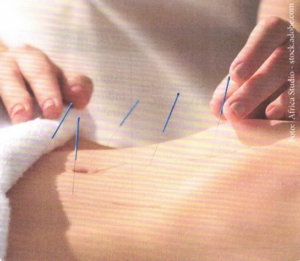 Figure 1: Acupuncture can be used
Figure 1: Acupuncture can be used
as part of holistic cancer treatment.
Risks of Integrative Therapy of Tumor Patients
Due to the lack of data, it is often not possible to assess whether tumor patients benefit from complementary adjunctive therapy or whether it may cause harm. As a result, it is always important to be aware that medicinal plants and micronutrients in particular can interact with chemotherapy or radiation therapy. On the one hand, this can increase the bioavailability of the drugs, which can increase the risk of side effects. On the other hand, the bioavailability of the drugs can also be impaired, which can reduce the effectiveness of chemotherapy.
Table 1 (following): Assessment of micronutrients in the S3-Guideline on Complementary Medicine in the Treatment of Oncological Patients (4)
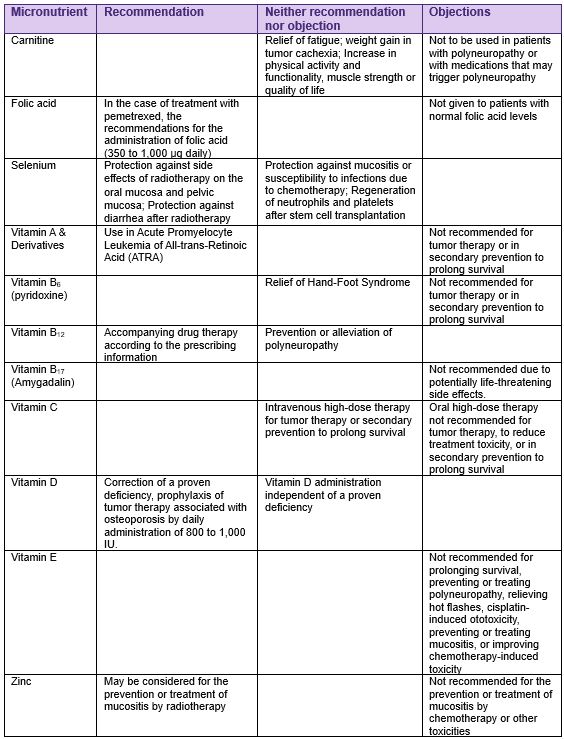
Integrative Micronutrient Therapy
The S3-Guideline on Complementary Medicine in the Treatment of Oncological Patients summarizes the evidence of studies on the integrative treatment of cancer patients with some micronutrients. The most important statements are listed in Table 1 (preceding on Page Four).
Other micronutrients are not listed in the Guideline due to a lack of data. When dealing with other micronutrients, one should therefore adhere to the basic principles for integrative therapy of cancer patients mentioned below.
Integrative Phytotherapy of Tumor Patients
In the S3-Guideline on Complementary Medicine in the Treatment of Oncological Patients several medicinal plants and secondary plant substances which are used in complementary cancer therapy are also listed in addition to micronutrients. The study situation on the effect and undesirable consequences of an application during oncological treatment are explained in detail. The most important statements are summarized Table 2.
Of course, phyto therapists lack many medicinal plants that they would like to use to alleviate side effects of conventional therapy or to improve the quality of life of those affected. Unfortunately – it can only be repeated – there are no studies on this. However, this does not mean that you have to avoid these medicinal herbs. However, you should be oriented by a few principles.
The study situation on complementary medicine in oncology is still quite poor.
Table 2 (following): Assessment of medicinal plants and secondary plant substances in the S3-Guideline on Complementary Medicine in the Treatment of Oncological Patients (4).
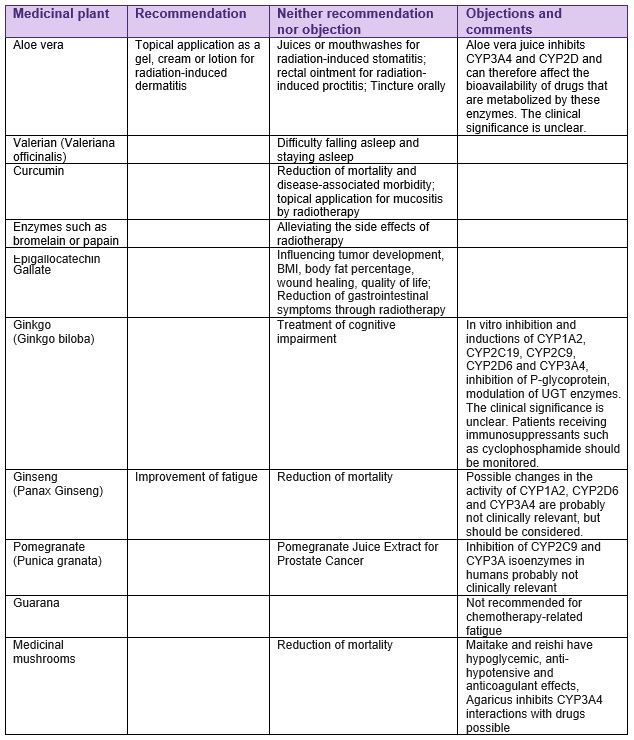
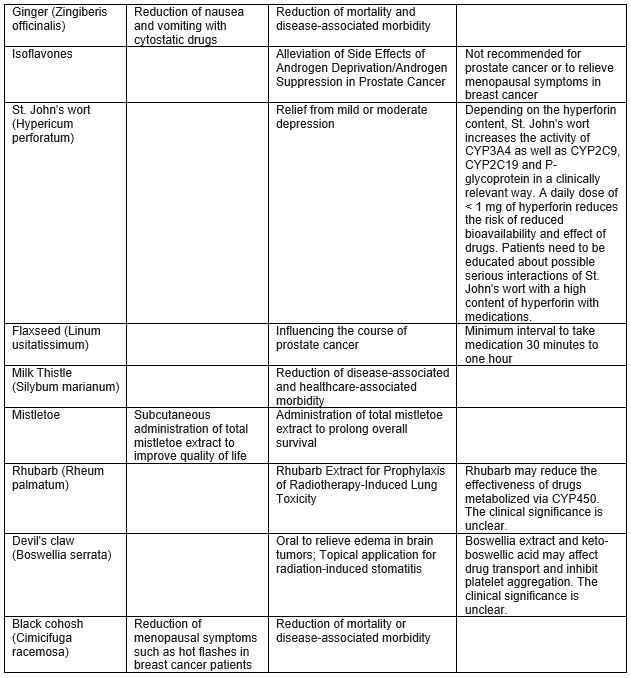
The treating physicians must be informed in detail about the planned integrative therapy.
General Tips for Integrative Treatment of Cancer Patients
Consent of the treating physicians: The treating physicians must be informed in detail about the planned integrative therapy and agree to it. Otherwise, phytotherapy or micronutrients must be used as part of follow-up care following conventional treatment.
- Patient education and informed consent: Patients should be informed about the lack of data on complementary treatment. You should be aware that there may be previously unknown interactions that can adversely influence conventional treatment. The contents of the consultation should be well documented in a consent form signed by the patient before acceptance of the treatment. Heed the warnings of the guideline authors. The guideline authors advise against only a few complementary approaches (see tables). This should be taken seriously.
- Interruption of complementary therapy: No phytotherapy or micronutrients 3-5 days before, during, and 3-5 days after chemotherapy to avoid drug interactions. Medicinal plants and micronutrients should therefore only be used in the therapy-free interval.
- Stay in dialogue: Regularly consult with patients about which therapy or dietary supplement they are using in the meantime, additionally because they often follow well-intentioned advice from friends, neighbors and relatives.
- Check the study situation: The therapist should check the study situation on integrative oncology at regular intervals.
The authors of the guideline advise against only a few complementary approaches.
Other Therapies in Integrative Oncology
For some procedures, such as acupuncture, acupressure, MBSR, meditation, Tai Chi and Qigong, which aim to improve symptoms and quality of life under tumor therapy, the guideline authors noted that they can be used “during and after adjuvant therapy” or “during and after completion of chemotherapy/radiation therapy”, but for example they recommend acupuncture for depression only after chemotherapy. In addition, some of the recommendations are limited to certain patient groups. This is often due to a lack of data (4).
Result
Safety should be the top priority in the complementary medical care of tumor patients. If an approach is unsuitable in a specific case, there are many alternatives that can improve the well-being and quality of life of those affected without jeopardizing the success of conventional medical treatment.
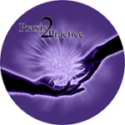
An Exclusive Translated Article for P2P Supporters
From the Monthly Publications of P2P
Published November 2023
From an article in Naturheilpraxis, Volume 76, September 2023
Machine Translation by Lernout & Hauspie, & Promt
Translation & redaction by: Carolyn L. Winsor, P2P Consulting
© Copyright 2023, Naturheilpraxis, Sabine Ritter, Munich, Germany
Literature
- Zentrum für Krebsregisterdaten, zuletzt besucht am 23.4.23 n.rpv.media/67z
- dkfz Krebsinformationsdienst Krebsstatistiken, zuletzt besucht am 23.3.23 n.rpv.media/67‑
- Onko Internetportal, zuletzt besucht am 23.3.23 n.rpv.media/680
- Leitlinienprogramm Onkologie (Deutsche Krebsgesellschaft, Deutsche Krebshilfe, AWMF): Komplementärmedizin in der Behandlung von onkologischen PatientInnen, Langversion 1.0, 2021, AWMF Registernummer: 032/055OL, nev.rpv.media/681



